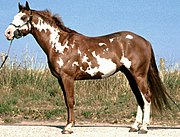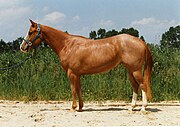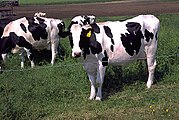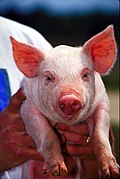Leucism
Aller à la navigation
Aller à la recherche

Deutsch: Weiße Katzen sind meist leuzistisch
English: *White cats usually are leucistic.
Deutsch: Leuzismus (Farblosigkeit) ist eine Defekt-Mutation die dazu führt, daß das Fell weiß und die darunterliegende Haut rosa ist, da die Haut keine Melanozyten (farbstoffbildende Zellen) enthält. Früher ordnete man alle Fälle von Leuzismus dem W-Lokus zu. Inzwischen ist bekannt, daß es mehrere unterschiedliche Gene gibt, deren Mutationen zu de:Leuzismus führen können. Dazu gehört der Endothelin-Rezeptor-B-Gen (EDNRB), das Paired Box Gen 3 (PAX3), SOX10, der Microphthalmie-assoziierter Transkriptionsfaktor (MITF), c-Kit und der Steel-Locus (codiert MGF). Die meisten Formen der Scheckung sind auf abgeschwächte Formen des Leuzismus zurückzuführen.
English: Leucism is a general term for the phenotype resulting from defects in pigment cell differentiation and/or migration from the neural crest to skin, hair or feathers during development. This results in either the entire surface (if all pigment cells fail to develop) or patches of body surface (if only a subset are defective) having a lack of cells capable of making pigment. Genes that, when mutated, can cause leucism include, c-kit, mitf and ednrb
Mutationen einzelner Genorte
[modifier]Endothelin-Rezeptor-B-Gen
[modifier]Deutsch: Menschen
- de:Morbus Hirschsprung (teilweise)
- Waardenburg-Shah-Syndrom oder WS4.
-
Deutsch: Bei den Spotting-lethal Ratten sind die Flecken etwa so verteilt, wie bei diesen Tieren, nur daß der Schwanz teilweise schwarz ist.English: heterocygous Rats with the spotting-lethal mutation of endothelin-B receptor gene look similar but the tail is black
c-Kit
[modifier]Deutsch: Der c-Kit-Locus der Maus ist unter anderem unter folgenden Namen bekannt: c-kit. belly-spot, dominant spotting, spotted sterile male, Steel Factor Receptor, Dominant white spotting, c-kit, proto-oncogene protein
English: Other names of c-Kit: c-kit. belly-spot, dominant spotting, spotted sterile male, Steel Factor Receptor, Dominant white spotting, c-kit, proto-oncogene protein
Maus
[modifier]-
New ENU-induced alleles at the Kit locus. (A) Three new point mutations inducing loss-of-function of the KIT protein (Sco1, Sco5 and Whc1) and one potential mutation affecting the regulation of the Kit gene (Sow3). Heterozygous individuals carrying the Sco1, Sco5, Sow3 and Whc1 mutations display white spotting on the belly and a white forehead blaze while homozygotes (-/-) have a white coat color with black eyes.
Mensch
[modifier]-
Weiße Stirnlocke beim de:Piebaldismus
Pferde
[modifier]-
Deutsch: Tobianoscheckung (Category:Tobiano)English: Category:Tobiano
-
Deutsch: SabinoscheckungEnglish: Sabino
-
Deutsch: Roan: StichelhaareEnglish: Category:Roan horses
-
(G) Immunohistochemistry using a polyclonal KIT antibody on a skin biopsy from a solid-colored horse. Blue staining indicates KIT expression throughout the epidermis. Melanin produced by melanocytes is visible as brown granules.
(H) Immunohistochemistry on a skin biopsy of a white horse. Note the weak blue staining and the complete absence of melanocytes and melanin. The bars correspond to 50 μm.
Rind
[modifier]Deutsch: Sehr wahrscheinlich ist die typische Scheckung die man von Holsteinern und Schwarzbunten Niederungsrindern kennt ebenfalls auf den Kit-Locus zurückzuführen.
English: The spotting of Holstein cattle is due to a varaition of c-Kit
-
Deutsch: Holsteiner KüheCategory:Holstein
Schwein
[modifier]Deutsch: Schwein: Sowohl die rosa Farbe der meisten Hochleistungsrassen, als auch verschiedene Scheckmuster als auch die Gürtelzeichnung einiger Schweinereassen werden durch Mutationen des KIT-Locus hervorgerufen.
English: The pink color of domestic pigs is due to a mutation of KIT-Locus, same is true for the belt mutation and the spotting of pigs.
Deutsch: Rosa Schweine
-
Ferkel, Piglets
-
Ferkel, Piglet
-
Sau mit Ferkeln, Sow and five piglets
Deutsch: gefleckte Schweine
English: spotting
-
Gescheckte Schweine
-
Gescheckte Ferkel
Deutsch: Gürtelzeichnung
English: belt mutation
Katze
[modifier]Deutsch: Katzen: Die weißen Flecken gescheckter Katzen werden sehr wahrscheinlich durch eine Mutation des c-Kit-Locus hervorgerufen.
Pax3
[modifier]Mensch
[modifier]de:Waardenburg-Syndrom Typ 1 und 3 (WS1 und WS3), das craniofacial-deafness-hand syndrome (wörtlich: Gesichtsschädel-Taubheits-Hand-Syndrom) und das Rhabdomyosarkom hervor.
Microphthalmie-assoziierter Transkriptionsfaktor (MITF)
[modifier]-
Deutsch: Leuzistische Mäuse mit Mutationen des Mitf-Gens können ebenso rosa Augen haben wie diese Albinos.English: Leucistic Mice with mutations of the Mitf-gene often have red or pink eyes like these albino mice
Sox10
[modifier]Steel-Locus
[modifier]Der Steel-Locus (Steel factor, SF, Steel) arbeitet eng mit dem c-Kit-Locus zusammen und wird deshalb auch Kitl (Kitlg, Kit ligand) genannt. Weitere Namen und Abkürzungen für den Steel-Locus sind: Sl; SLF; contrasted (Con), cloud gray (Clo), grizzle-belly (Gb), stem cell factor (SCF), mast cell growth factor (Mgf).
Rind
[modifier]-
Deutsch: Weißblauer Belgier - Die stichelhaarige Farbe dieser Rasse und der Shorthorn-Rinder ist auf eine mutation des Steel-Locus zurückzuführenEnglish: Belgian Blue cattle
-
English: Shorthorn - the roan color of Shorthorn (here viewable only in the dark patches) and oft Blue bleu belge are due to a mutation of the Steel-LocusDeutsch: Shorthorn-Rind mit weißen Stichelhaaren in den dunklen Flecken
Quellen
[modifier]Endothelinrezeptor
[modifier]- Ling Hou, William J. Pavan, Myung K. Shin und Heinz Arnheiter: Cell-autonomous and cell non-autonomous signaling through endothelin receptor B during melanocyte development. In: Development 131, 3239-3247 Published by The Company of Biologists 2004 doi:10.1242/dev.01193
- CHERYL E. GARIEPY, DANIEL T. CASS AND MASASHI YANAGISAWA: Medical Sciences Null mutation of endothelin receptor type B gene in spotting lethal rats causes aganglionic megacolon and white coat color. In: Proc. Natl. Acad. Sci. USA Vol. 93, pp. 867–872, January 1996, http://www.pnas.org/cgi/content/abstract/93/2/867?ck=nck copie d'archive sur Wayback Machine
- Metallinos DL, Bowling AT, Rine J: A missense mutation in the endothelin-B receptor gene is associated with Lethal White Foal Syndrome: an equine version of Hirschsprung disease. In: Mamm Genome. 1998 Jun;9(6):426-31. PMID: 9585428 https://www.ncbi.nlm.nih.gov/entrez/query.fcgi?db=pubmed&cmd=Retrieve&dopt=AbstractPlus&list_uids=9585428&query_hl=3&itool
- Santschi EM, Vrotsos PD, Purdy AK, Mickelson JR: Incidence of the endothelin receptor B mutation that causes lethal white foal syndrome in white-patterned horses. In: Am J Vet Res. 2001 Jan;62(1):97-103. PMID: 11197568
- G. C. Yang, D. Croaker, A. L. Zhang, P. Manglick, T. Cartmill and D. Cass: A dinucleotide mutation in the endothelin-B receptor gene is associated with lethal white foal syndrome (LWFS); a horse variant of Hirschsprung disease (HSCR). In: Oxford University Press, Human Molecular Genetics, 1998, Vol. 7, No. 6, S.1047–1052.
- Jeanne Amiel, Tania Attié, Dominique Jan, Anna Pelet, Patrick Edery, Christelle Bidaud, Didier Lacombe, Paul Tam, Juliette Simeoni, Elisabeth Flori, Claire Nihoul-Fékété, Arnold Munnich and Stanislas Lyonnet: Heterozygous endothelin receptor B (EDNRB) mutations in isolated Hirschsprung disease. 1996 Oxford University Press 355–357, Human Molecular Genetics, 1996, Vol. 5, No. 3
c-Kit
[modifier]- NCBI - Kit kit oncogene (Mus musculus)
- Olga Maksimovic: Untersuchungen zur Expression des c-kit-Rezeptors bei der Entstehung und Progression des malignen Melanoms. Inaugural-Dissertation zur Erlangung des Doktorgrades der Medizin, Universitätshautklinik Tübingen http://tobias-lib.ub.uni-tuebingen.de/volltexte/2006/2376/index.html copie d'archive sur Wayback Machine
- Edwin N. Geissler, Melanie A. Ryan and David E. Housman: The dominant-white spotting (W) locus of the mouse encodes the c-kit proto-oncogene. In: Cell. Volume 55, Issue 1 , 7 October 1988, Pages 185-192, doi:10.1016/0092-8674(88)90020-7
- Fleischman RA: Human piebald trait resulting from a dominant negative mutant allele of the c-kit membrane receptor gene. In: J Clin Invest. 1992 Jun;89(6):1713-7. PMID: 1376329
- Brooks SA, Bailey E: Exon skipping in the KIT gene causes a Sabino spotting pattern in horses. In: Mamm Genome. 2005 Nov;16(11):893-902. Epub 2005 Nov 11. PMID: 16284805
- Hai-Bin Ruan, Nian Zhang and Xiang Gao: Identification of a Novel Point Mutation of Mouse Proto-Oncogene c-kit Through N-Ethyl-N-nitrosourea Mutagenesis. Genetics. 2005 Feb;169(2):819-31. http://www.pubmedcentral.nih.gov/articlerender.fcgi?tool=pubmed&pubmedid=15731517
- M. Johansson Moller, R. Chaudhary, E. Hellmén, B. Höyheim, B. Chowdhary, L. Andersson: Pigs with the dominant white coat color phenotype carry a duplication of the KIT gene encoding the mast/stem cell growth factor receptor In: Mammalian Genome, Springer New York, ISSN 0938-8990 (Print) 1432-1777 (Online), Volume 7, Number 11 / November 1996, DOI 10.1007/s003359900244, S. 822-830
- Giuffra E, Evans G, Tornsten A, Wales R, Day A, Looft H, Plastow G, Andersson L: The Belt mutation in pigs is an allele at the Dominant white (I/KIT) locus. In: Mamm Genome. 1999 Dec;10(12):1132-6. PMID: 10594235
- Giuffra E, Tornsten A, Marklund S, Bongcam-Rudloff E, Chardon P, Kijas JM, Anderson SI, Archibald AL, Andersson L: A large duplication associated with dominant white color in pigs originated by homologous recombination between LINE elements flanking KIT. In: Mamm Genome. 2002 Oct;13(10):569-77. PMID: 12420135
- MP Cooper, N Fretwell, SJ Bailey, and LA Lyons: White spotting in the domestic cat (Felis catus) maps near KIT on feline chromosome B1. Anim Genet. 2006 April; 37(2): 163–165. doi: 10.1111/j.1365-2052.2005.01389.x.
- Marklund S, Moller M, Sandberg K, Andersson L: Close association between sequence polymorphism in the KIT gene and the roan coat color in horses. Mamm Genome. 1999 Mar;10(3):283-8. PMID: 10051325 https://www.ncbi.nlm.nih.gov/entrez/query.fcgi?db=pubmed&cmd=Retrieve&dopt=AbstractPlus&list_uids=10051325&query_hl=82&itool=pubmed_docsum
- C. Mau, P. A. Poncet, B. Bucher, G. Stranzinger, S. Rieder: Genetic mapping of dominant white (W), a homozygous lethal condition in the horse (Equus caballus). In: Journal of Animal Breeding and Genetics 121 (6), Volume 121, Issue 6, S.374–383 http://www.doi.org/abs/10.1111/j.1439-0388.2004.00481.x
- Reinsch N, Thomsen H, Xu N, Brink M, Looft C, Kalm E, Brockmann GA, Grupe S, Kuhn C, Schwerin M, Leyhe B, Hiendleder S, Erhardt G, Medjugorac I, Russ I, Forster M, Reents R, Averdunk G: A QTL for the degree of spotting in cattle shows synteny with the KIT locus on chromosome 6. In: J Hered. 1999 Nov-Dec;90(6):629-34. PMID: 10589513 https://www.ncbi.nlm.nih.gov/entrez/query.fcgi?db=pubmed&cmd=Retrieve&dopt=AbstractPlus&list_uids=10589513&query_hl=17&itool=pubmed_docsum
- Grosz MD, MacNeil MD: The "spotted" locus maps to bovine chromosome 6 in a Hereford-Cross population. In: J Hered. 1999 Jan-Feb;90(1):233-6. MID: 9987932 https://www.ncbi.nlm.nih.gov/entrez/query.fcgi?db=pubmed&cmd=Retrieve&dopt=AbstractPlus&list_uids=9987932&query_hl=19&itool=pubmed_docsum
Pax3
[modifier]- Waardenburg syndrome, type I https://www.ncbi.nlm.nih.gov/omim/?term=193500
- Craniofacial-deafness-hand Syndrome https://www.ncbi.nlm.nih.gov/omim/?term=122880
- Rhabdomyosarcoma 2 https://www.ncbi.nlm.nih.gov/omim/?term=268220
- Waardenburg syndrome, type III https://www.ncbi.nlm.nih.gov/omim/?term=148820
- Pax3 paired box gene 3 (Mus musculus) https://www.ncbi.nlm.nih.gov/entrez/query.fcgi?db=gene&cmd=Retrieve&dopt=full_report&list_uids=18505
- Phenotypic Alleles http://www.informatics.jax.org/searches/allele_report.cgi?markerID=MGI:97487
- M. Ptok und S. Morlot: Einseitige Innenohrschwerhörigkeit bei Mutationen im PAX3-Gen bei Waardenburg-Syndrom Typ I. In: HNO, Springer Berlin / Heidelberg, ISSN 0017-6192 (Print) 1433-0458 (Online), Volume 54, Number 7 / Juli 2006, 557-560, DOI 10.1007/s00106-005-1315-1
MITF
[modifier]- NCBI: Mitf (Drosophila melanogaster), GeneID: 3885647, Stand: 21-Feb-2007, https://www.ncbi.nlm.nih.gov/entrez/query.fcgi?db=gene&cmd=Retrieve&dopt=full_report&list_uids=3885647
- NCBI: Mitf microphthalmia-associated transcription factor (Mus musculus), GeneID: 4286, Stand: 05-Apr-2007, https://www.ncbi.nlm.nih.gov/entrez/query.fcgi?db=gene&cmd=Retrieve&dopt=Graphics&list_uids=4286
- NCBI: MITF microphthalmia-associated transcription factor (Homo sapiens) GeneID: 4286, Stand: 08-Apr-2007, https://www.ncbi.nlm.nih.gov/entrez/query.fcgi?db=gene&cmd=Retrieve&dopt=full_report&list_uids=4286
- NCBI: Tietz syndrome, MIM: 103500
- NCBI: Waardenburg syndrome, type IIA, MIM: 193510
- NCBI: Waardenburg syndrome/ocular albinism, digenic, MIM: 103470
Sox10
[modifier]- Sandra Wißmüller: Biochemische Analyse der Eigenschaften der HMG-Domäne des Transkriptionsfaktors Sox10. naturwissenschaftlichen Fakultäten der Friedrich-Alexander-Universität Erlangen-Nürnberg, 2006 http://www.opus.ub.uni-erlangen.de/opus/volltexte/2006/459/
- Prof. Michael Wegner: Mechanistische Analyse der Interaktion zwischen den Transkriptionsfaktoren Sox10 und Pax3, Lehrstuhl für Biochemie und Pathobiochemie, Institut für Biochemie, Uni Erlangen http://www.biologie.uni-erlangen.de/mibi/gradkoll/11wegner.htm copie d'archive sur Wayback Machine
- NCBI: Sox10 SRY-box containing gene 10 (Mus musculus), GeneID: 20665, Stand:24-Mar-2007
- Mouse Genome Informatics: http://www.informatics.jax.org/searches/allele_report.cgi?markerID=MGI:98358
- NCBI: SOX10 SRY (sex determining region Y)-box 10 (Homo sapiens), GeneID: 6663, Stand: 08-Apr-2007, https://www.ncbi.nlm.nih.gov/entrez/query.fcgi?db=gene&cmd=Retrieve&dopt=full_report&list_uids=6663
Steel
[modifier]- NCBI: Kitl kit ligand (Mus musculus). GeneID: 17311, Stand: 05-Apr-2007, https://www.ncbi.nlm.nih.gov/entrez/query.fcgi?db=gene&cmd=Retrieve&dopt=full_report&list_uids=17311
- Mouse Genome Informatics: Kitl, Phenotypic Alleles, Stand: 16.04.07 http://www.informatics.jax.org/searches/allele_report.cgi?markerID=MGI:96974
- Charlier C, Denys B, Belanche JI, Coppieters W, Grobet L, Mni M, Womack J, Hanset R, Georges M: Microsatellite mapping of the bovine roan locus: a major determinant of White Heifer disease. Mamm Genome. 1996 Feb;7(2):138-42, PMID: 8835531, https://www.ncbi.nlm.nih.gov/entrez/query.fcgi?db=gene&cmd=Display&dopt=gene_pubmed&from_uid=280856
- Seitz JJ, Schmutz SM, Thue TD, Buchanan FC: A missense mutation in the bovine MGF gene is associated with the roan phenotype in Belgian Blue and Shorthorn cattle. In: Mamm Genome. 1999 Jul;10(7):710-2. PMID: 10384045 https://www.ncbi.nlm.nih.gov/entrez/query.fcgi?db=pubmed&cmd=Retrieve&dopt=AbstractPlus&list_uids=10384045&query_hl=13&itool=pubmed_docsum




































